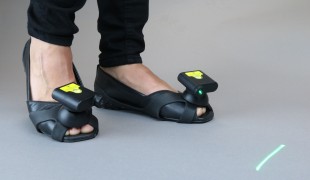- 7686
- 523
- 6
- 6
- 0
- Help Ukraine
About the solution
John’s wife is visually impaired. Despite of her disability, John wanted to share his passion for winter sport with his wife. In 1996, he sketched a design for an adaptive tool on a paper napkin, and he decided to create a new device called Sno-Wing.
“I had few ideas that there would be so many benefits for so many challenged users--including my wife.”, he recalled. This is why, in 1998, the Sno-Wing was patented.
The Sno-Wing is an adaptive training device designed to allow a guide maximum control of their participant’s movements whilst snowboarding. It looks like a lightweight elliptical frame with a padded harness.To hold, the harness is attached at the pivot point of the disabled person’s hip.
To stabilise the Sno-Wing, there are several connection points. Connecting straps provide adjustability to suit a variety of sizes and needs.
The Sno-Wing can be used for both snowboarding and skiing.
Since receiving the patent, the Sno-Wing has been supplied to winter sport schools around the globe.
More info : http://www.sno-wing.com/index.htm
https://www.youtube.com/watch?v=mxMDzpTSs9I
This solution shall not include mention to the use of drugs, chemicals or biologicals (including food); invasive devices; offensive, commercial or inherently dangerous content. This solution was not medically validated. Proceed with caution! If you have any doubts, please consult with a health professional.
DISCLAIMER: This story was written by someone who is not the author of the solution, therefore please be advised that, although it was written with the utmost respect for the innovation and the innovator, there can be some incorrect statements. If you find any errors please contact the patient Innovation team via info@patient-innovation.com
-
-
391
-
0
-
5506

Researcher invents fabric to help blind people navigate more easily
WALKING: Walking
BODY BALANCE: Maintaining body balance
Blindness
Body-Worn solutions (Clothing, accessories, shoes, sensors...)
Assistive Daily Life Device (to help ADL)
Vision problems
Difficulty coordinating movements
Maintaining Balance and Mobility
Preventing (Vaccination, Protection, Falls, Research/Mapping)
Neurology
Ophthalmology
Tunisia
-
-
-
848
-
7
-
18712

Path Finder - a shoe attachment to alleviate 'freezing of gait' in Parkinson's
WALKING: Walking
BODY BALANCE: Maintaining body balance
STANDING UP: Standing up from a seated position
Parkinson's Disease
Body-Worn solutions (Clothing, accessories, shoes, sensors...)
Assistive Daily Life Device (to help ADL)
Frequent falls
Gait abnormalities (e.g., walking difficulties, unsteady gait)
Loss of balance
Stiffness or rigidity (difficulty moving)
Tremors
Recovering cognitive function
Promoting self-management
Managing Neurological Disorders
Maintaining Balance and Mobility
Neurology
Physical Medicine and Rehabilitation
Denmark
-
-
-
236
-
0
-
2425

The Ramble Tag guidance aid - designed for use between guide and visually impaired person
WALKING WITH A WALKING AID: Walking with a walking aid
CAREGIVING
Hiking
Traveling
Blindness
Body-Worn solutions (Clothing, accessories, shoes, sensors...)
Walking Aid (wheelchair/walker/crutches)
Assistive Daily Life Device (to help ADL)
Strategy/Tip
Vision problems
Building Supportive Community Relationships
Promoting inclusivity and social integration
Maintaining Balance and Mobility
Preventing (Vaccination, Protection, Falls, Research/Mapping)
Caregiving Support
Ophthalmology
United Kingdom
-
 en
en